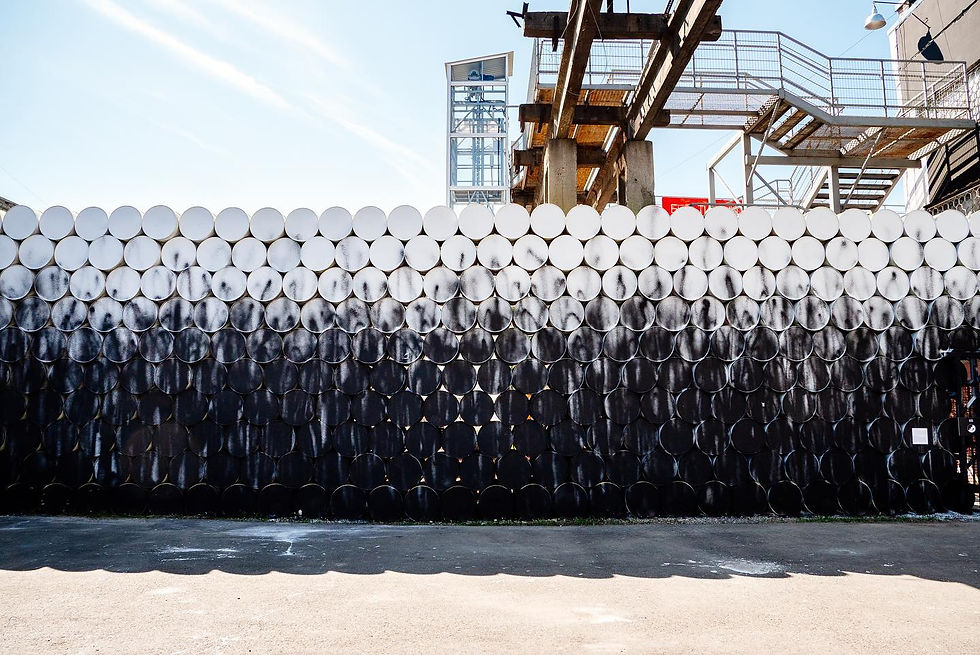Bleeding Edges: Painting as Psychic Residue in a Post-Tactile Age
- Tom Denman

- Mar 28, 2023
- 4 min read

In Fade to Grief, Anna Mikholap presents a body of work that does not so much extend her painterly concerns as transform the very ground on which they rest. Exhibited at Atticus Gallery in Bath, this small but conceptually rich quartet of paintings signals a material and philosophical shift—a transition from the atmospheric, spectral figuration of her earlier practice towards a posthuman poetics of disintegration. These are not representations of mourning; they are grief itself, dispersed, dissipated, and rendered through animal embodiment and chromatic instability.
The works resist the stabilising conventions of figuration through a sustained refusal to provide the viewer with legible subjects. Their support—aluminium—functions not as a surface but as a partner in tension. Unlike canvas, aluminium resists absorption. The pigment is not absorbed but skates, stutters, and hesitates. Every gesture enacts negotiation, not assertion. This resistance is not purely formal; it has ontological weight. The body, in Mikholap’s work, is not a fixed vessel of identity. It is a porous, collapsing threshold between sensation and disappearance.
The first painting offers a canine figure, upright but fading. Ochre pigment fills the torso, while the legs and head dissolve into red lines and ambiguous mark-making. The background—a haunting mixture of teal and mauve—includes a glitch-like streak of digital interference near the horizon. The figure does not meet our gaze; instead, it withdraws from it, refusing reciprocal recognition. This dog is not symbolic. It is not a metaphor for grief. It is grief as creature—embodied, alert, and dissolving.
The second work continues the canine motif, but this time the figure is folded inward, outlined in blue against a ground of warm umber. It gestures ambiguously—perhaps grooming, perhaps retreating. The limbs dislocate slightly from anatomical logic. The result is not abstraction, but emotional topography—a body drawn as if under the pressure of memory rather than form. The viewer cannot locate a fixed point; instead, one is drawn into a durational encounter with the unfinished.
In the third painting, form breaks down almost entirely. The figure is prone—green, black, white—barely a silhouette, more suggestion than form. The surface becomes a kind of affective weather system. The eye seeks structure, but what it finds is only the residue of collapse. This is grief not as event, but as spatial condition—grief as fog, as drift.
The fourth work presents a significant divergence: the appearance of a human figure. Unlike the canine forms, the man here—rendered in deep reds and shadowed greens—is indistinct. He appears not painted, but bled into the surface. His posture is unclear; his presence is spectral. Whereas the dogs strain against abstraction, the man is already consumed by it. He offers no stable subjectivity, no return to human centrality. Instead, he serves as a reminder of the fragility of that very claim.
Mikholap’s use of aluminium heightens this fragility. It forces the paint to perform: to struggle, to persist. The material reality of the work enacts a deeper philosophical position: that presence is not guaranteed, and that painting must labour to hold the trace. This aligns her practice with Édouard Glissant’s defence of opacity—the right not to be fully seen or understood¹—and Bracha Ettinger’s matrixial theory of aesthetic transmission as shared vulnerability rather than communicative exchange².
Mikholap does not offer us resolution, because grief offers none. These works are not interpretive puzzles. They do not yield meaning in proportion to the viewer’s gaze. Instead, they demand affective endurance. To witness them is to witness the image come apart, gently but unrelentingly. To sit with these paintings is to sit with ungraspable loss.
What Fade to Grief offers is not a collection of paintings, but a field of psychic sediment. The images do not hold. They bleed at the edge—of anatomy, of figuration, of comprehension. Mikholap does not paint the aftermath of grief. She paints the impossibility of aftermath. In doing so, she makes painting itself mournful—not by content, but by structure.
This is a practice attuned to what remains after the tactile contract has failed. These are paintings made not from touch, but from what remains when touch is no longer possible. They ask not to be seen, but to be stayed with. In a time of speed, saturation, and spectacle, they insist on opacity, duration, and quiet devastation.
Here, in the edges that fail to hold, we encounter grief not as story, but as atmosphere. Not as representation, but as the act of unravelling.
References
Édouard Glissant, Poetics of Relation, trans. Betsy Wing (Ann Arbor: University of Michigan Press, 1997).
Bracha L. Ettinger, The Matrixial Borderspace (Minneapolis: University of Minnesota Press, 2006).
Brian Massumi, Parables for the Virtual: Movement, Affect, Sensation (Durham: Duke University Press, 2002).
Hito Steyerl, The Wretched of the Screen (Berlin: Sternberg Press, 2012).
Tom Denman, residing in London, is a distinguished freelance art critic whose perceptive articles have featured in eminent publications such as Art Journal, ART PAPERS, ArtReview, Art Monthly, Burlington Contemporary, e-flux, Flash Art, Ocula, and Studio International. He earned his PhD in Italian Studies from the University of Reading, focusing his research on Caravaggio and the noble-intellectual milieu of seventeenth-century Naples. Presently, his critiques primarily explore the subtleties and emerging trends within contemporary art.










Comments